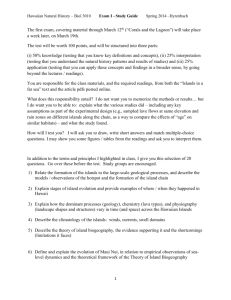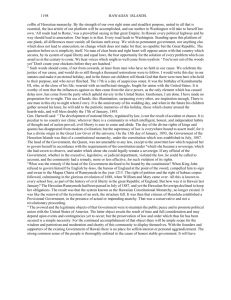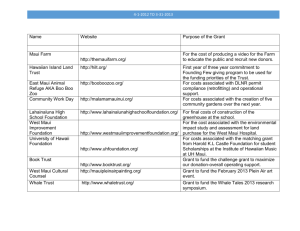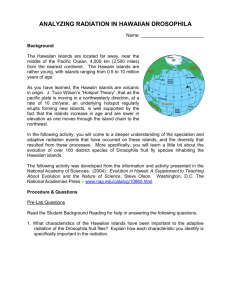doc file - University Corporation for Atmospheric Research
advertisement
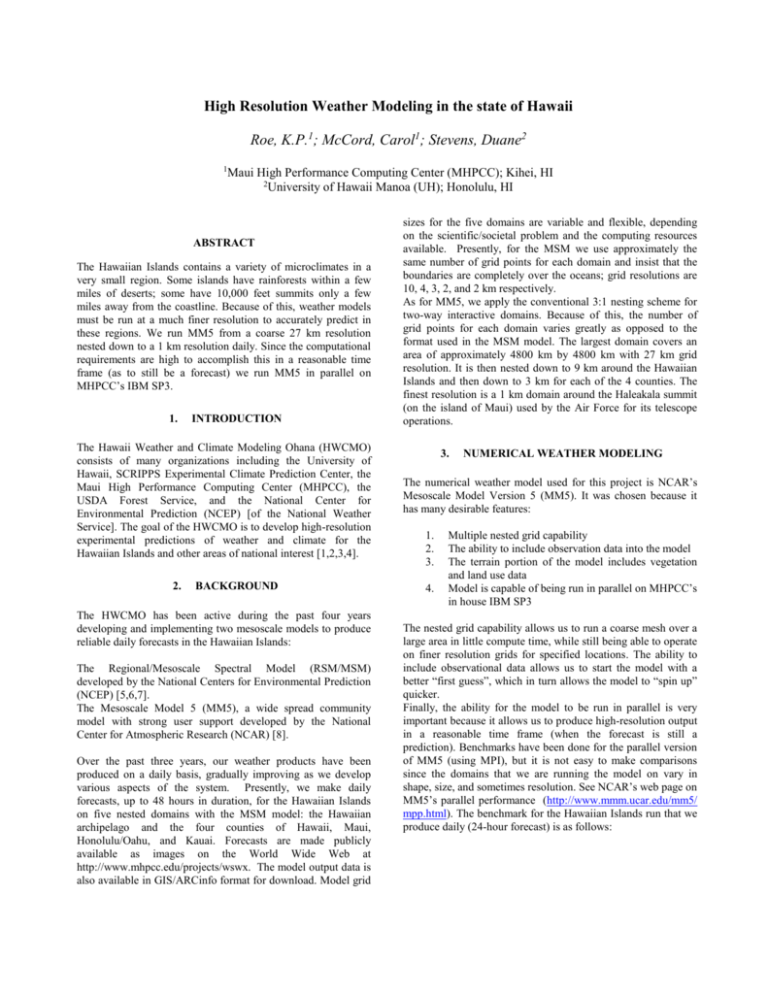
High Resolution Weather Modeling in the state of Hawaii Roe, K.P.1; McCord, Carol1; Stevens, Duane2 1 Maui High Performance Computing Center (MHPCC); Kihei, HI 2 University of Hawaii Manoa (UH); Honolulu, HI ABSTRACT The Hawaiian Islands contains a variety of microclimates in a very small region. Some islands have rainforests within a few miles of deserts; some have 10,000 feet summits only a few miles away from the coastline. Because of this, weather models must be run at a much finer resolution to accurately predict in these regions. We run MM5 from a coarse 27 km resolution nested down to a 1 km resolution daily. Since the computational requirements are high to accomplish this in a reasonable time frame (as to still be a forecast) we run MM5 in parallel on MHPCC’s IBM SP3. 1. INTRODUCTION The Hawaii Weather and Climate Modeling Ohana (HWCMO) consists of many organizations including the University of Hawaii, SCRIPPS Experimental Climate Prediction Center, the Maui High Performance Computing Center (MHPCC), the USDA Forest Service, and the National Center for Environmental Prediction (NCEP) [of the National Weather Service]. The goal of the HWCMO is to develop high-resolution experimental predictions of weather and climate for the Hawaiian Islands and other areas of national interest [1,2,3,4]. 2. BACKGROUND The HWCMO has been active during the past four years developing and implementing two mesoscale models to produce reliable daily forecasts in the Hawaiian Islands: The Regional/Mesoscale Spectral Model (RSM/MSM) developed by the National Centers for Environmental Prediction (NCEP) [5,6,7]. The Mesoscale Model 5 (MM5), a wide spread community model with strong user support developed by the National Center for Atmospheric Research (NCAR) [8]. Over the past three years, our weather products have been produced on a daily basis, gradually improving as we develop various aspects of the system. Presently, we make daily forecasts, up to 48 hours in duration, for the Hawaiian Islands on five nested domains with the MSM model: the Hawaiian archipelago and the four counties of Hawaii, Maui, Honolulu/Oahu, and Kauai. Forecasts are made publicly available as images on the World Wide Web at http://www.mhpcc.edu/projects/wswx. The model output data is also available in GIS/ARCinfo format for download. Model grid sizes for the five domains are variable and flexible, depending on the scientific/societal problem and the computing resources available. Presently, for the MSM we use approximately the same number of grid points for each domain and insist that the boundaries are completely over the oceans; grid resolutions are 10, 4, 3, 2, and 2 km respectively. As for MM5, we apply the conventional 3:1 nesting scheme for two-way interactive domains. Because of this, the number of grid points for each domain varies greatly as opposed to the format used in the MSM model. The largest domain covers an area of approximately 4800 km by 4800 km with 27 km grid resolution. It is then nested down to 9 km around the Hawaiian Islands and then down to 3 km for each of the 4 counties. The finest resolution is a 1 km domain around the Haleakala summit (on the island of Maui) used by the Air Force for its telescope operations. 3. NUMERICAL WEATHER MODELING The numerical weather model used for this project is NCAR’s Mesoscale Model Version 5 (MM5). It was chosen because it has many desirable features: 1. 2. 3. 4. Multiple nested grid capability The ability to include observation data into the model The terrain portion of the model includes vegetation and land use data Model is capable of being run in parallel on MHPCC’s in house IBM SP3 The nested grid capability allows us to run a coarse mesh over a large area in little compute time, while still being able to operate on finer resolution grids for specified locations. The ability to include observational data allows us to start the model with a better “first guess”, which in turn allows the model to “spin up” quicker. Finally, the ability for the model to be run in parallel is very important because it allows us to produce high-resolution output in a reasonable time frame (when the forecast is still a prediction). Benchmarks have been done for the parallel version of MM5 (using MPI), but it is not easy to make comparisons since the domains that we are running the model on vary in shape, size, and sometimes resolution. See NCAR’s web page on MM5’s parallel performance (http://www.mmm.ucar.edu/mm5/ mpp.html). The benchmark for the Hawaiian Islands run that we produce daily (24-hour forecast) is as follows: Procs 16 32 64 128 Time (seconds) 17639 10462 7452 5203 Time (H:M) 4:54 2:54 2:04 1:27 Relative Speedup 1.00 1.69 2.37 3.39 Parallel Efficiency 1.00 0.85 0.59 0.42 A relative speedup is used because the job had too high of a memory requirement that forced it to be run on no less than 16 processors. Even though this may not seem so impressive at first, this is a very complex set of nested domains. Additional capabilities have been added to the process of obtaining these forecasts. They include: (a) Highly reliable (fault tolerant) scripts that allow for quick changes (b) Script will retrieve the most recent pre-processing data (global analysis, observational data, etc) (c) Parallel image and data post-processing for web posting The fault tolerant script ensures that the operation will adjust and continue even in the face of an error or will report that there is a process ending error. The script has been written to be smart enough to retrieve the latest preprocessing data if it is not already present on the system; this ensures that the simulation will have the most recent data and/or avoid downloading data that is already present. Parallel image and data processing (through the use of child processes on a 16 way SMP) has been show to achieve a speedup close to the number of images/fields being produced for each domain. For example, we achieve a speedup of approximately 6 when processing 7 images (image production takes about 7½ minutes in parallel relative to 45¼ minutes sequentially for a 24 hour forecast in the Hawaiian Islands). Examples of the images (and the corresponding data behind them) produced for daily use can be seen in Figures 1 & 2: 4. Figure 1: Wind speed and direction around the Hawaiian Islands at a 9km resolution. CONCLUSIONS We have created a methodology that will produce fine resolution weather forecasts for the state of Hawaii. This methodology is focused on providing the required forecasts in a minimal time as to still be useful to the everyone from the general public to scientist at Haleakala using it to determine if the weather predictions are within their operational limits. Future work would entail increasing the resolution of the model (i.e. sub-kilometer resolution simulations), decreasing the response time of the entire operation, and expanding the coverage area outside of the Hawaiian Islands to Guam, the American Samoa, and Ponape. Figure 2: Rainfall around Maui County in the Hawaiian Islands at 3 km resolution. 2001 MM5 Workshop 5. REFERENCES [1] Stevens, D. “Hawaii Weather Climate Modeling Ohana.” California/Nevada/Hawaii meeting of western Foresters. April, 2000. Maui, HI. [2] Stevens, D., Funayama, D., Fujioka, F. “Numerical Weather Prediction for Fire Hazards on Oahu/Hawaii.” Third Symposium on Fire and Forest Meteorology. January 2000, Long Beach, CA. [3] Roe, K. P., McCord, C., Stevens, D., “Weather Data Management and archiving at the Maui High Performance Computing Center,” Fire Conference 2000: The First National Congress on Fire Ecology, Prevention and Management, San Diego, 2000. [4] Roe, K. P., Stevens, D., McCord, C., “Simulations and Forecasts of Weather/Fire Behavior for Disasters and Emergencies,” First International Global Disaster Information Network (GDIN), Honolulu, HI, 2000. [5] Wang, J.H., M.H. Juang, K. Kodama, and J. Partain, “Application of the NCEP regional spectral model to improve severe weather forecasts in Hawaii.” Weather Analysis and Forecasting. March, 1998 [6] Wang, J., M.H. Juang, and J. Partain, “Application of the NCEP nested regional spectral model for weather forecasts in Hawaii.” 11th Conference on Numerical Weather Prediction, Norfolk, Virginia, Amer. Metero. Soc., 6A7. [7] Juang, M.H., “The NCEP Mesoscale Spectral Model: A revised version of the nonhydrostatic regional spectral model.” Mon. Wea Rev., 128, 2329-2362. [8] Grell, Georg, Dudhia, Jimy, Stauffer, David, “A Description of the Fifth-Generation Penn State/NCAR Mesoscale Model.” NCAR Technical Note 398. June 1995.
